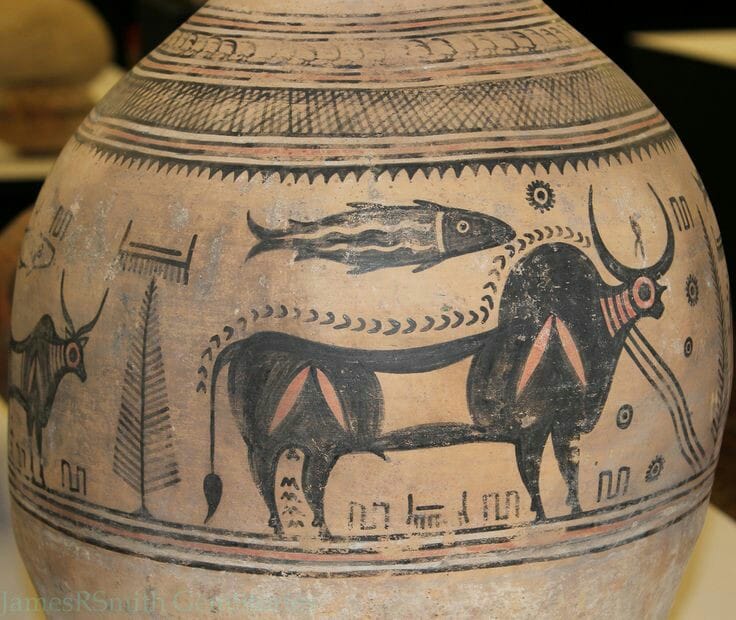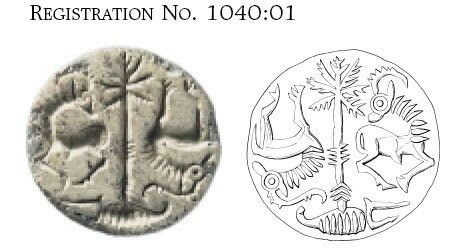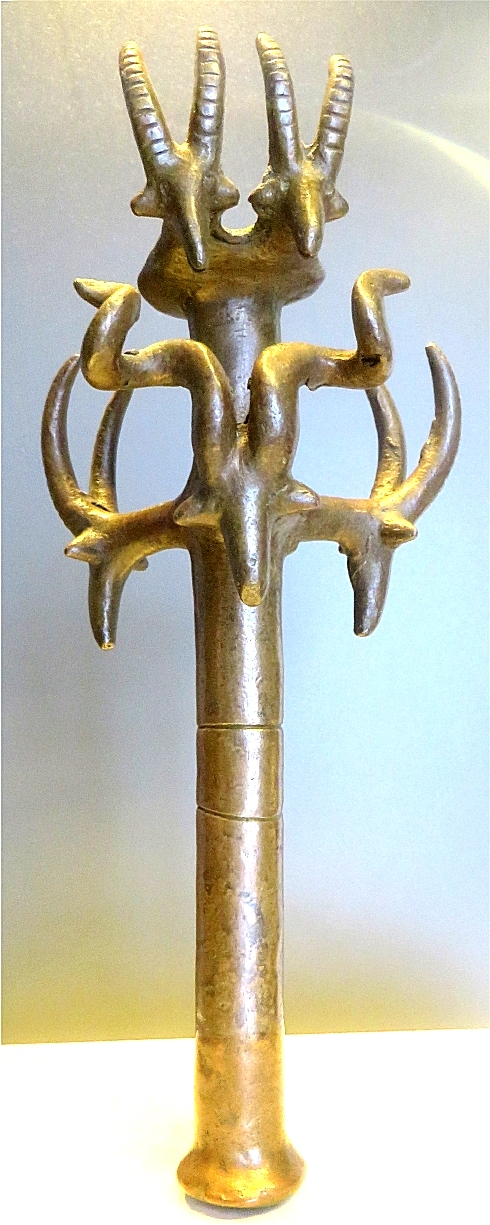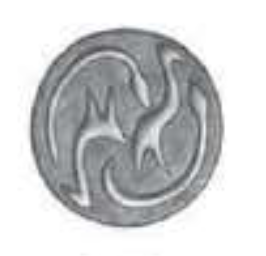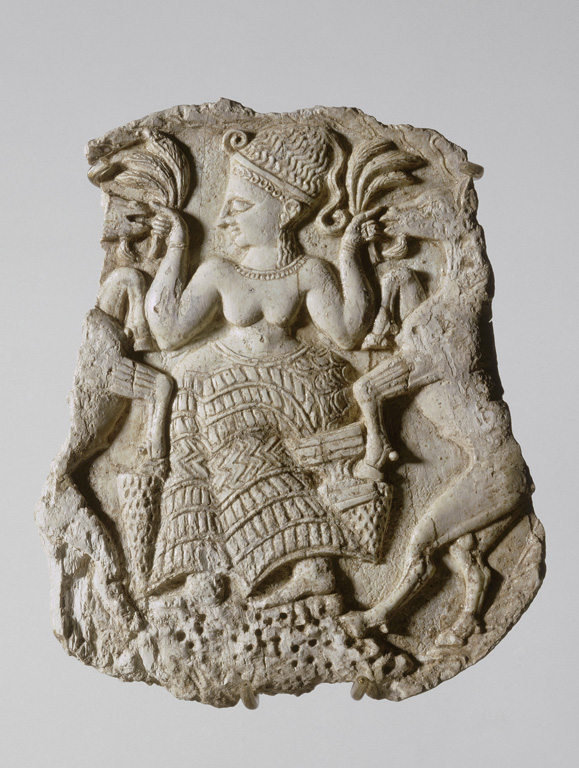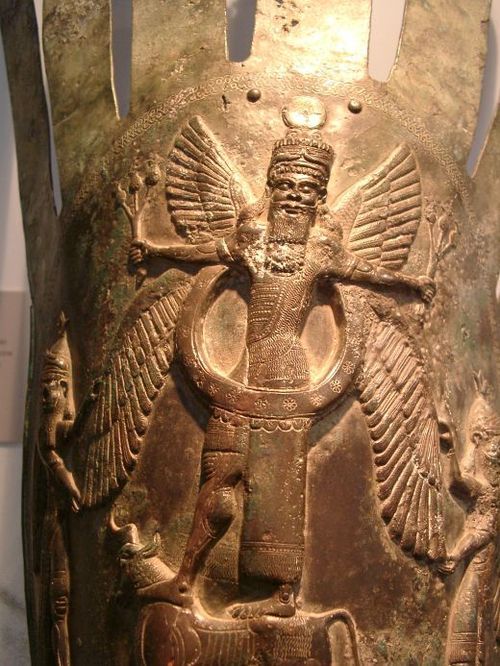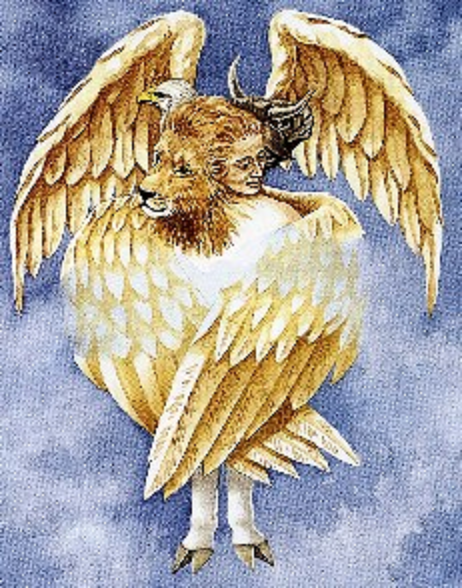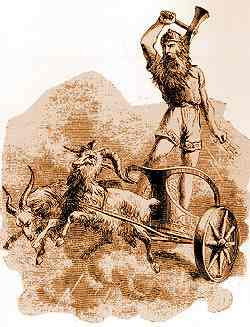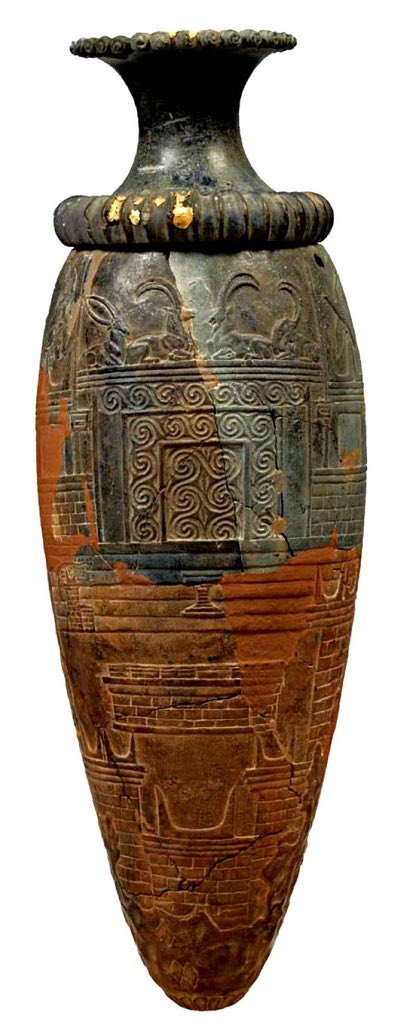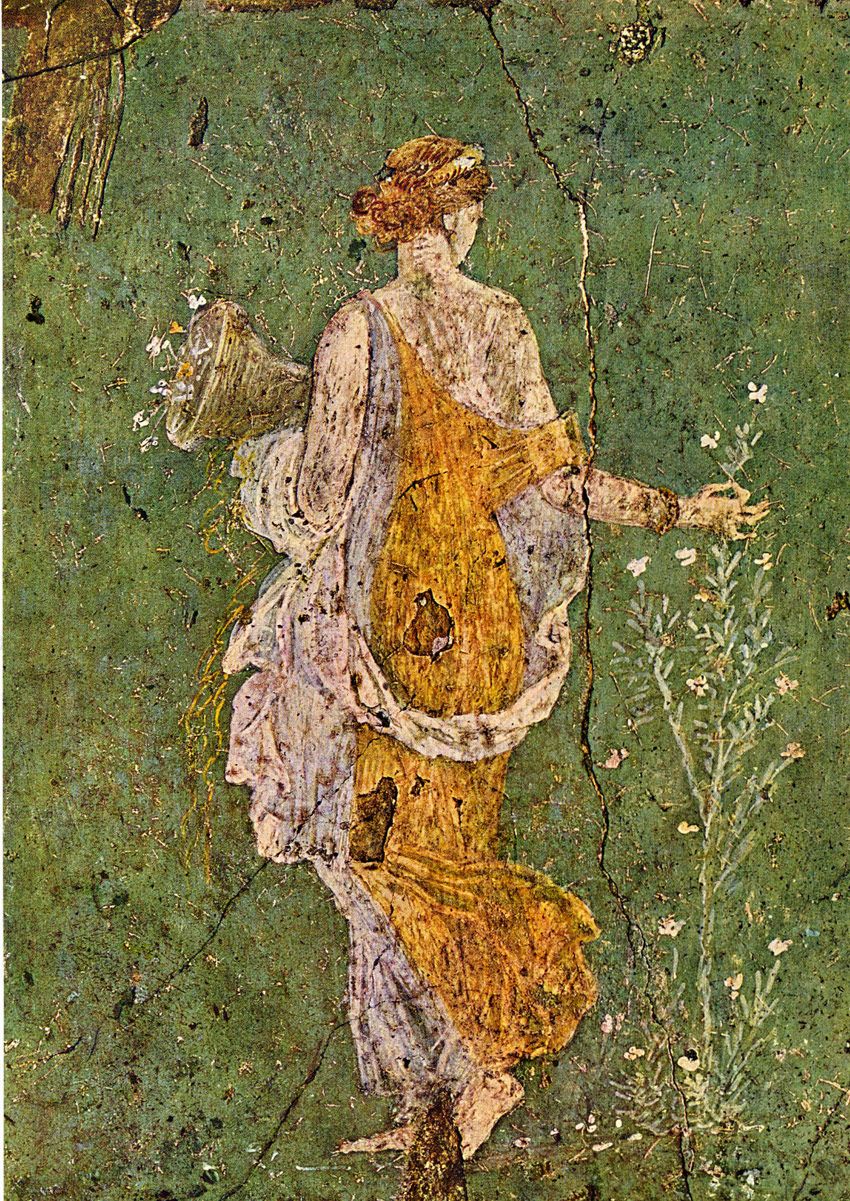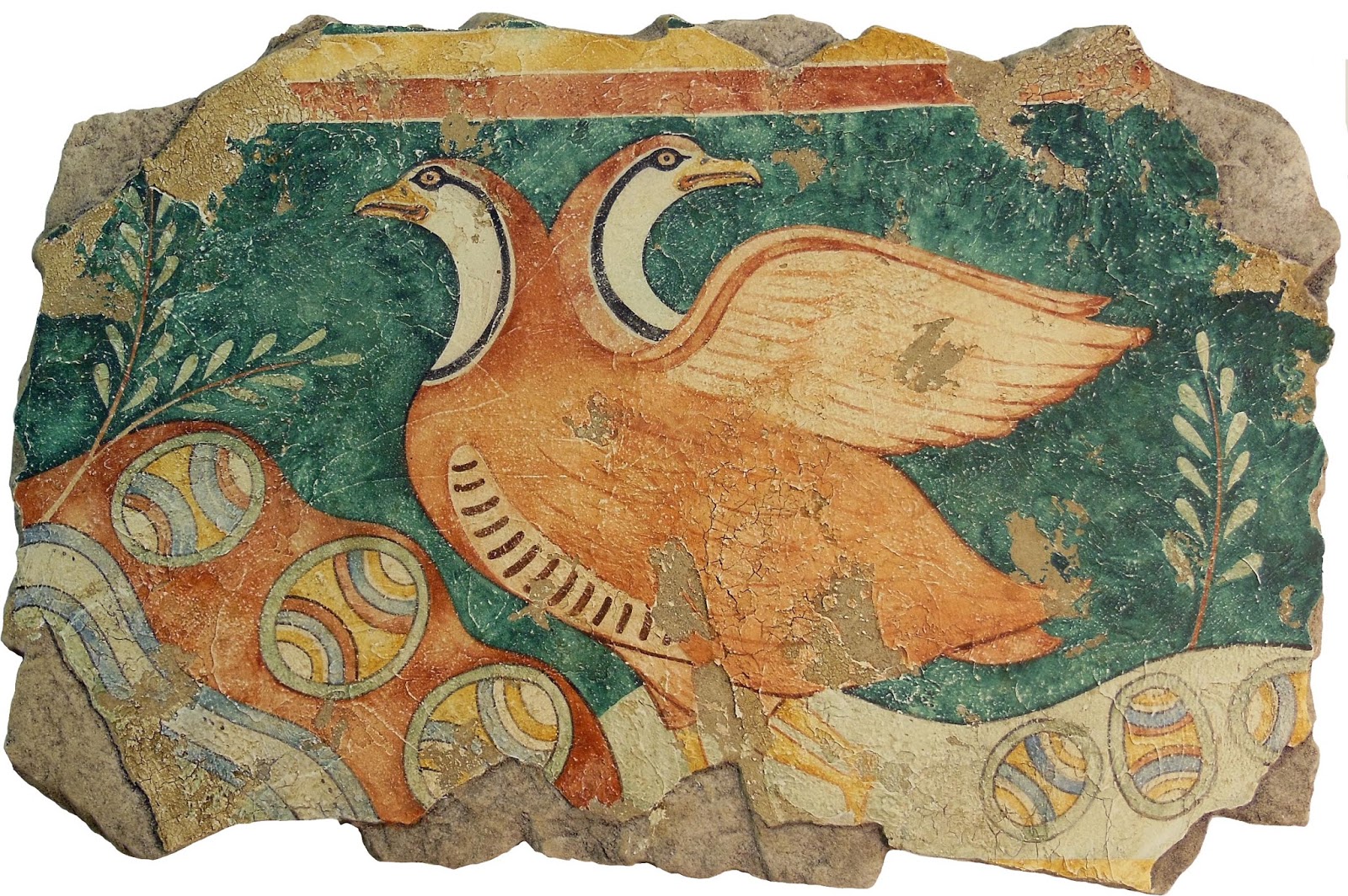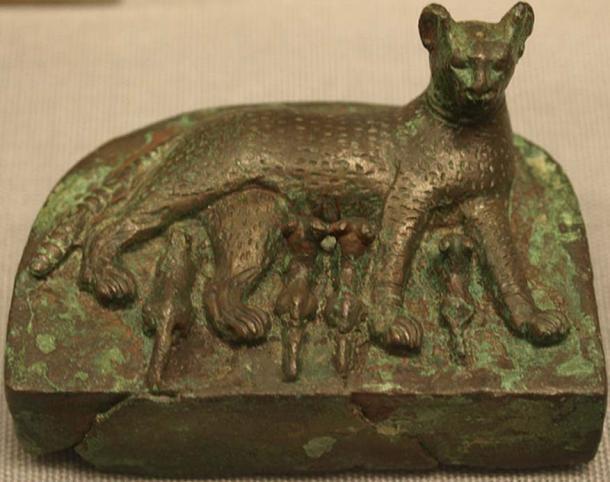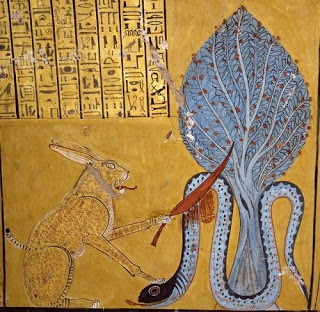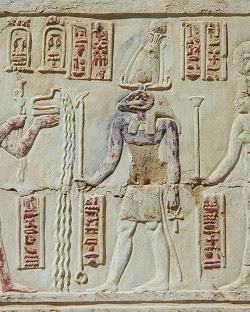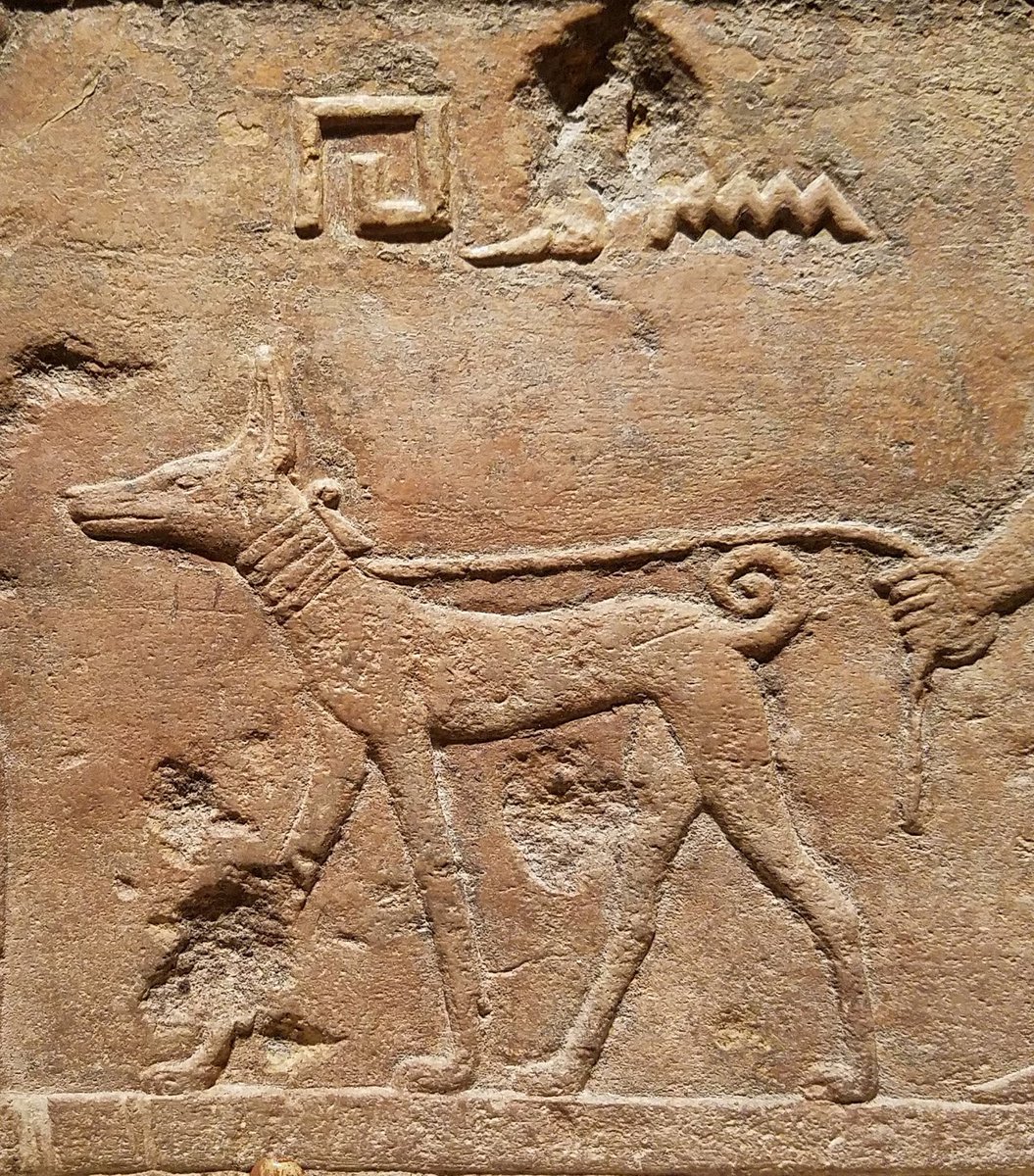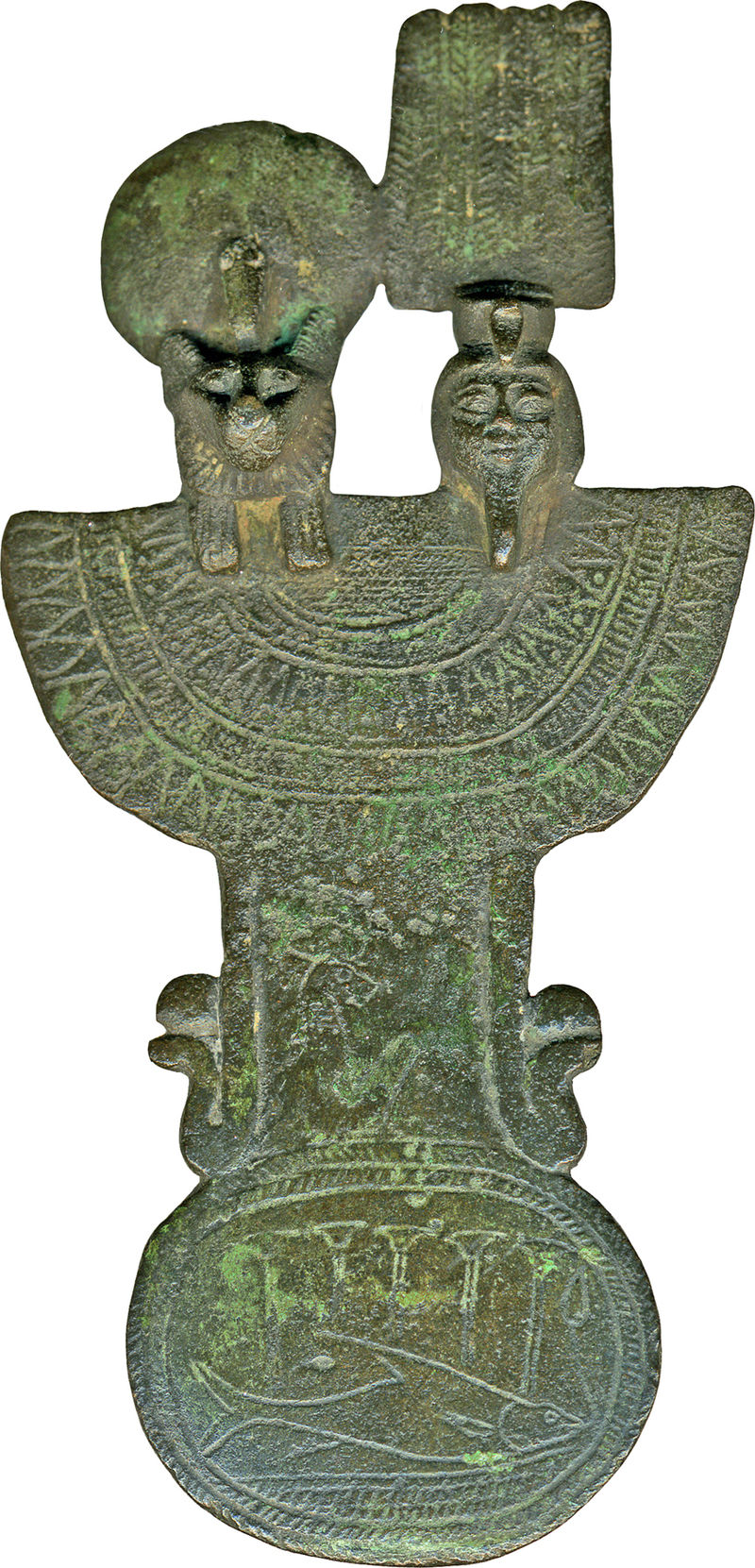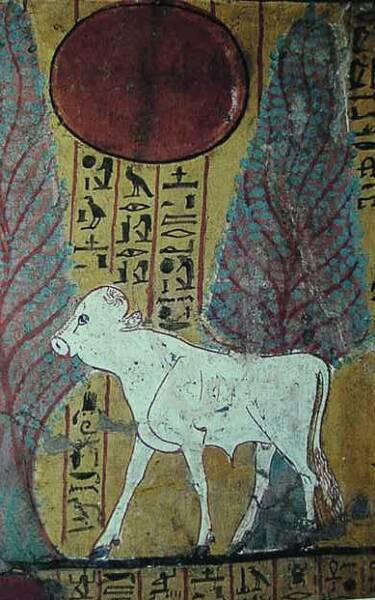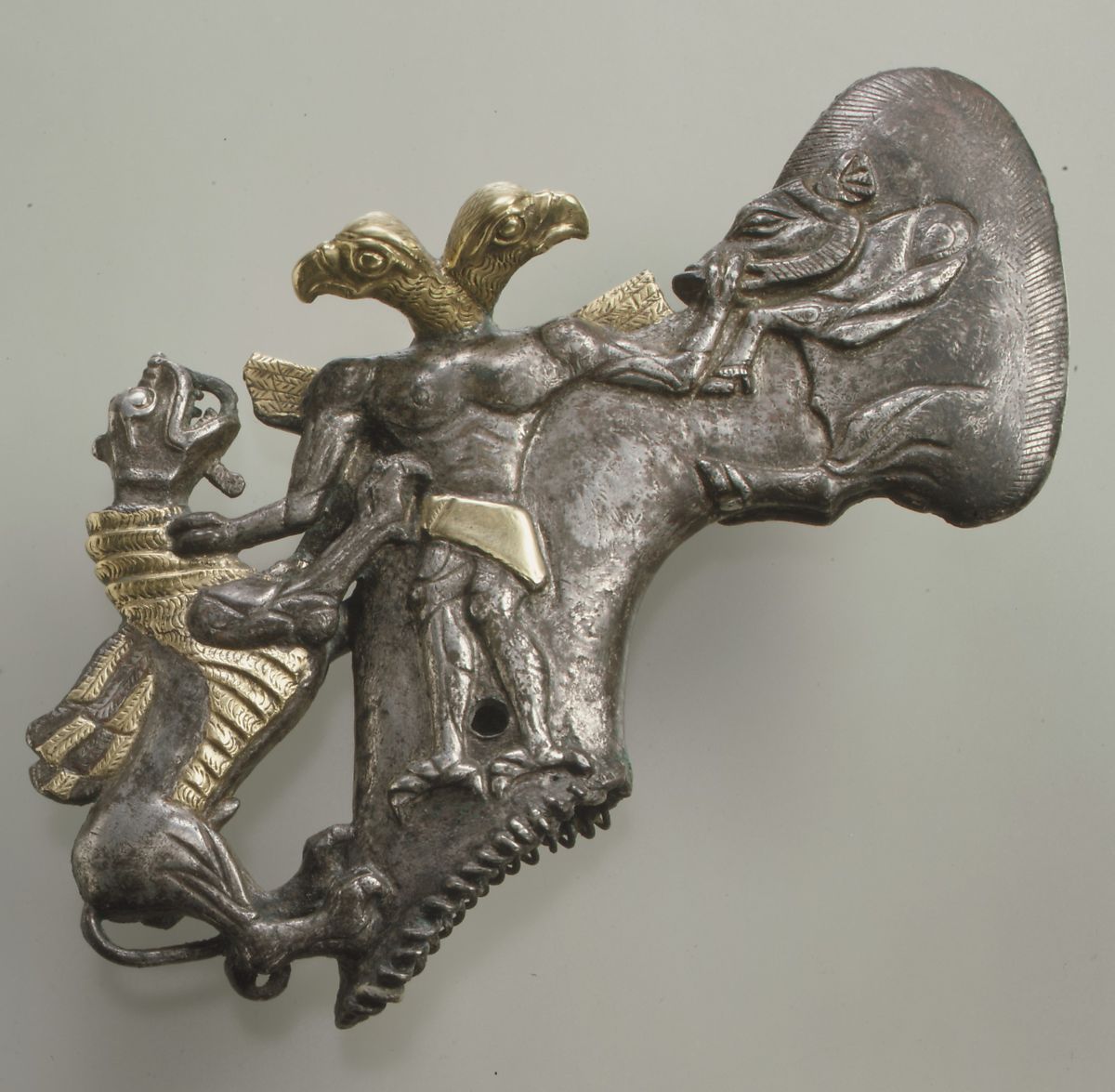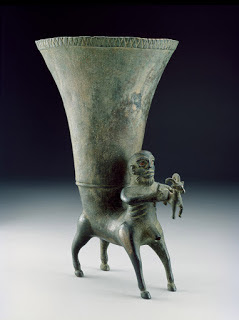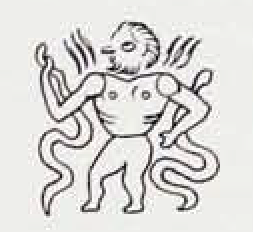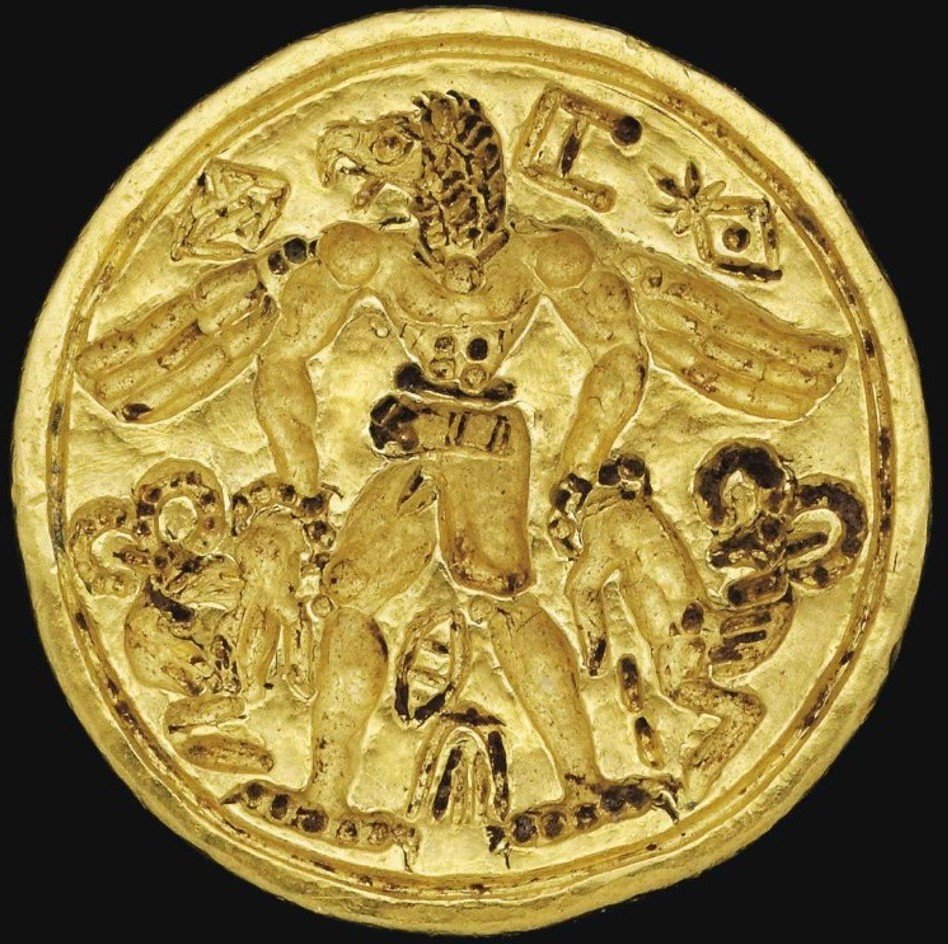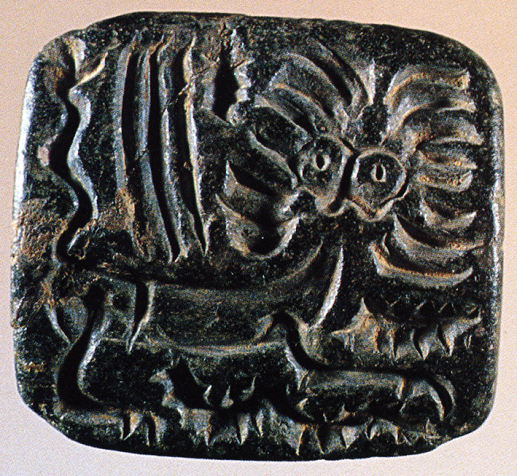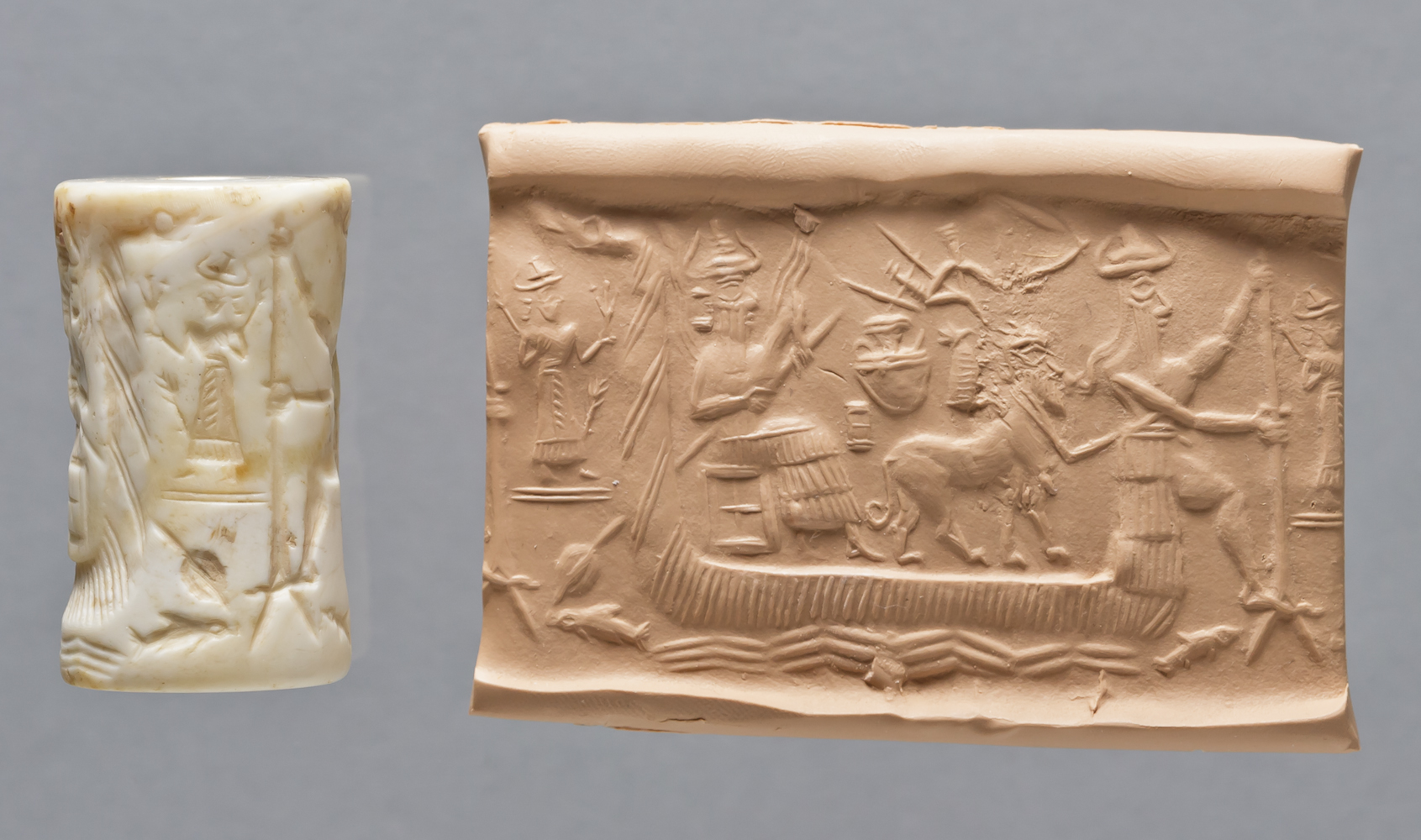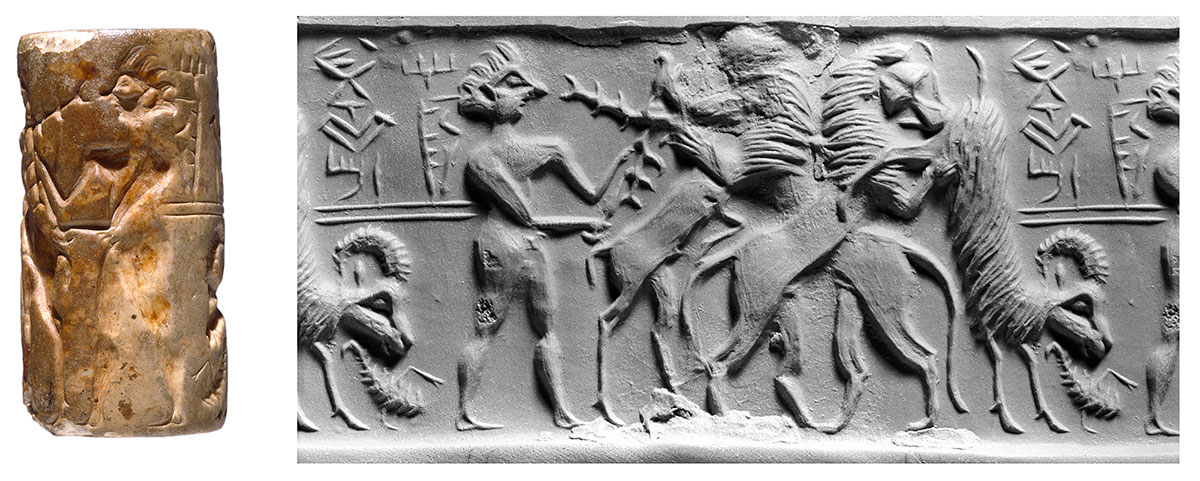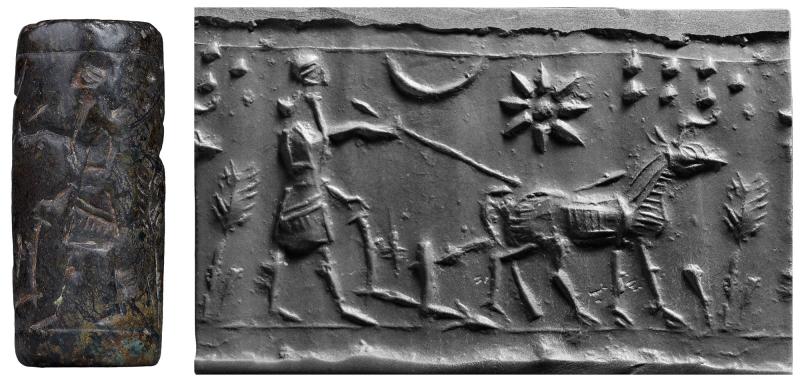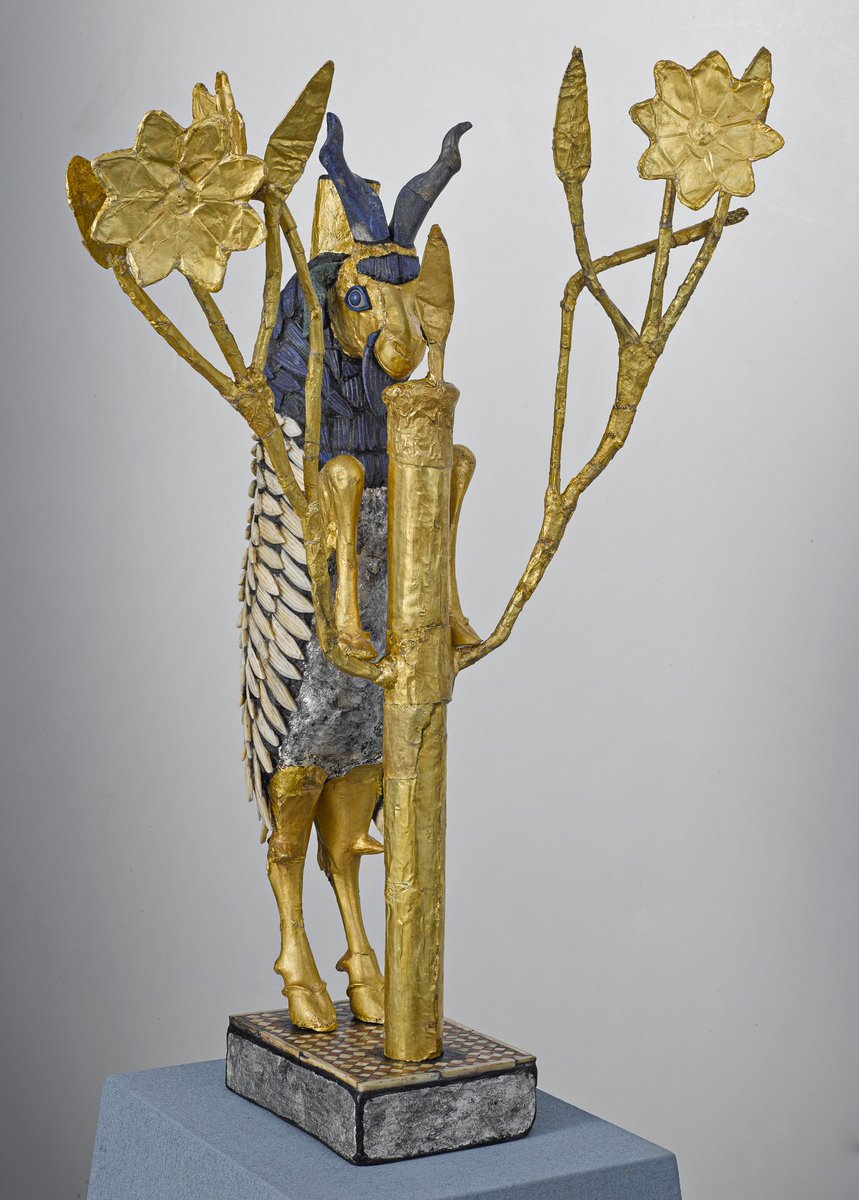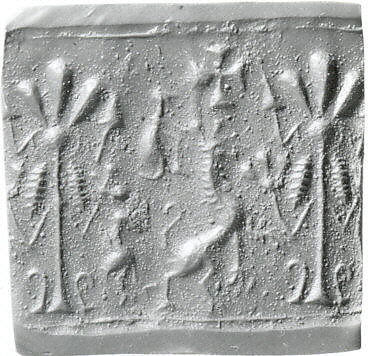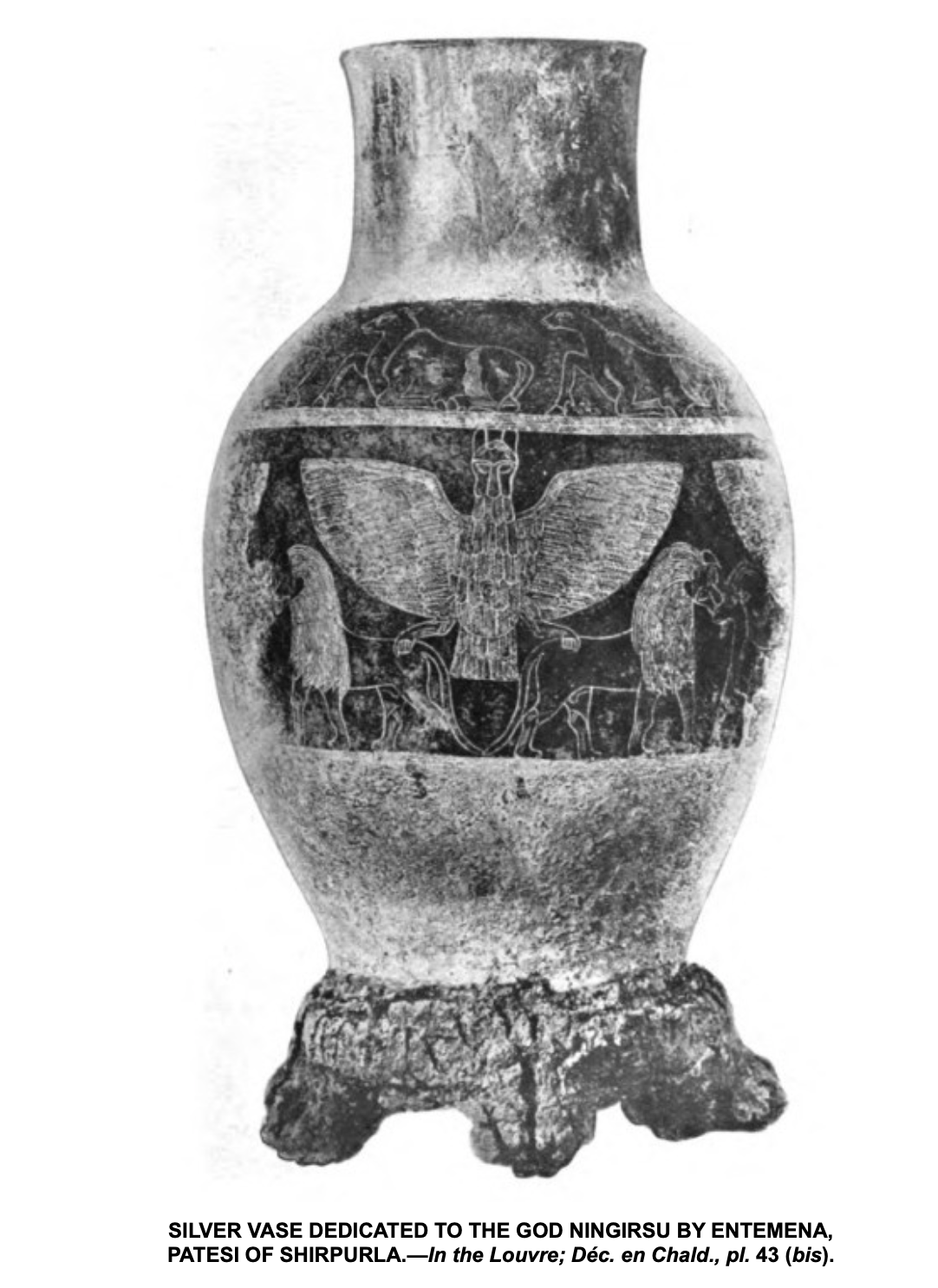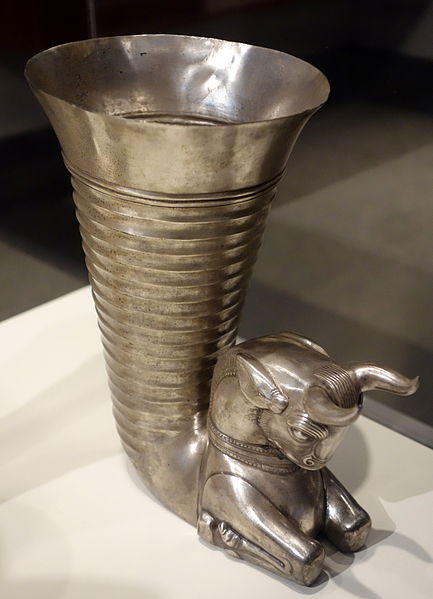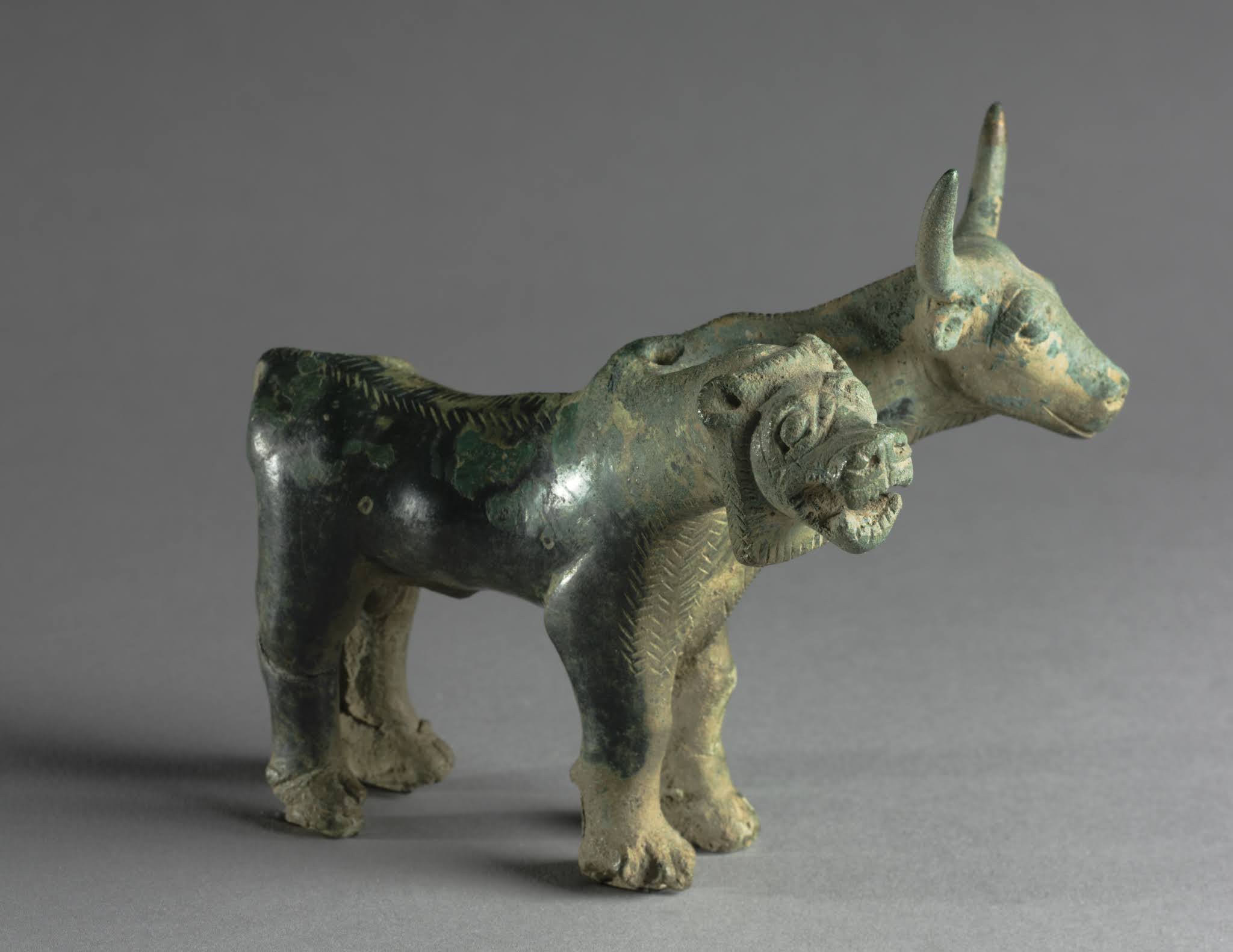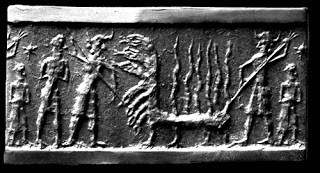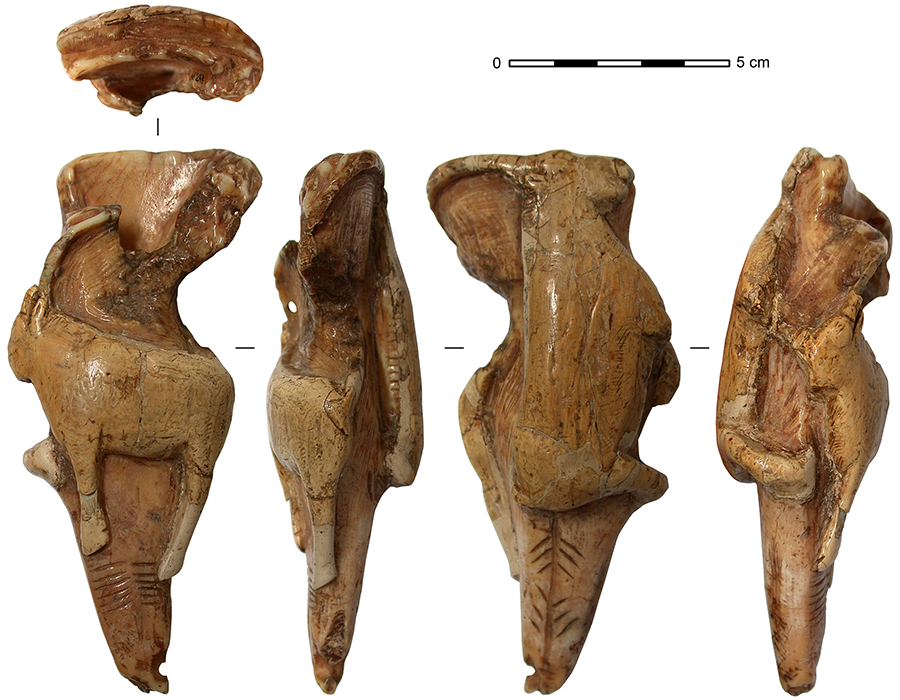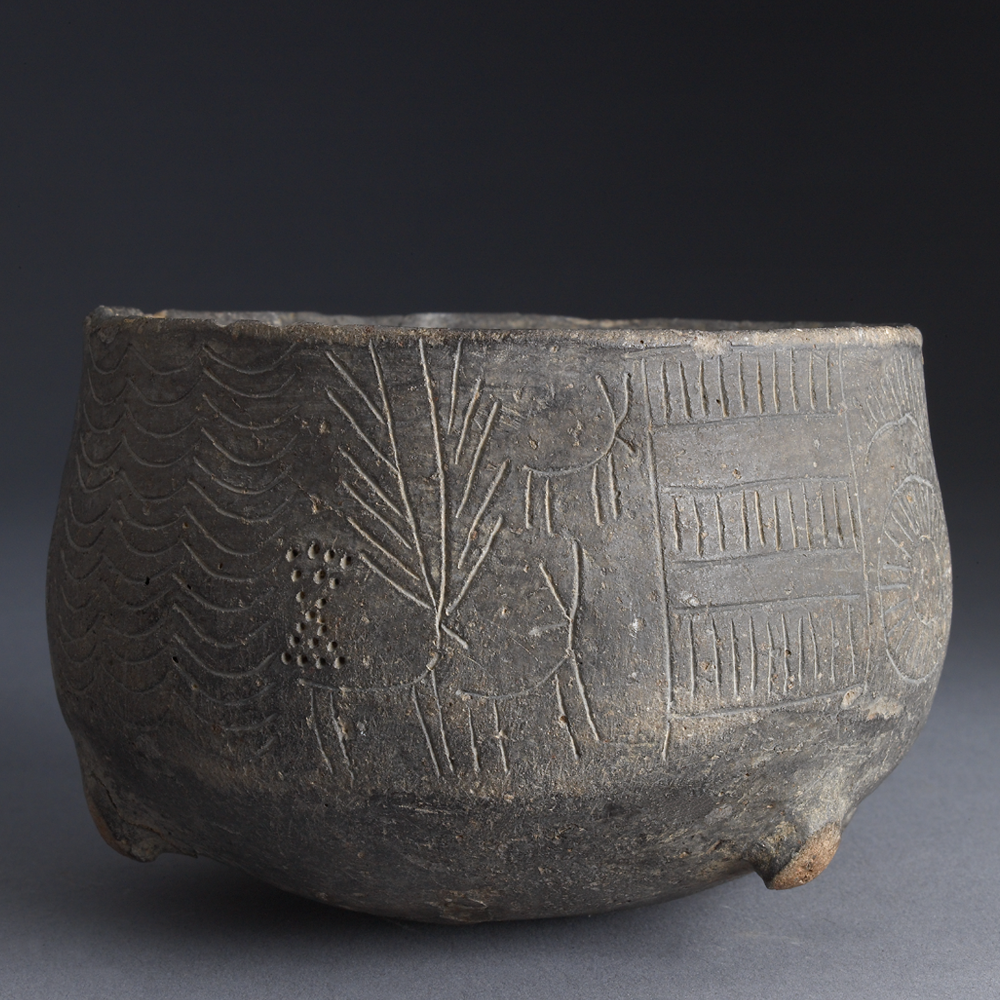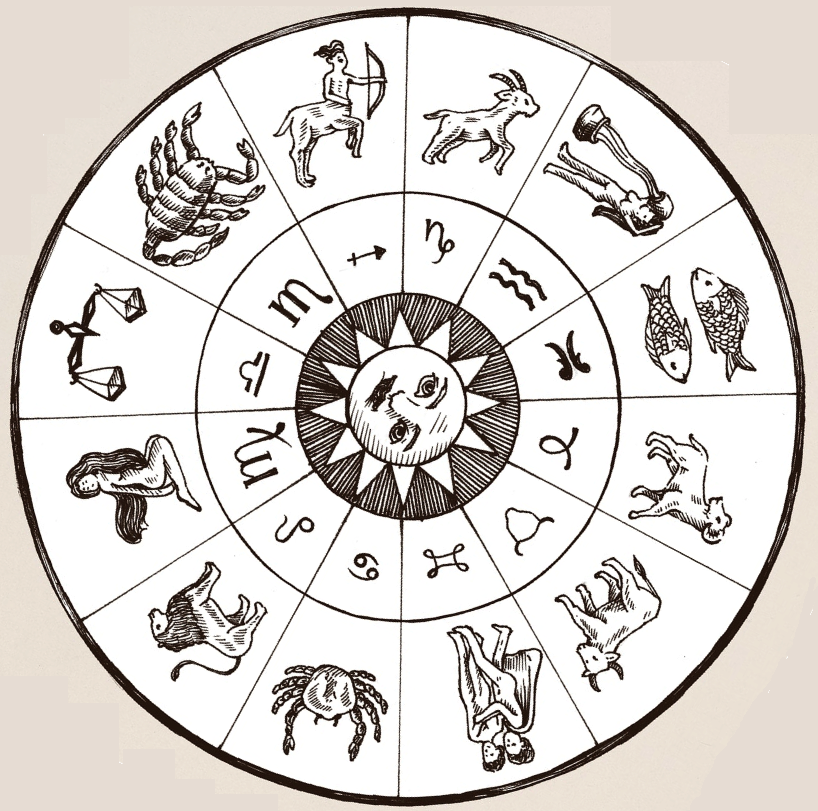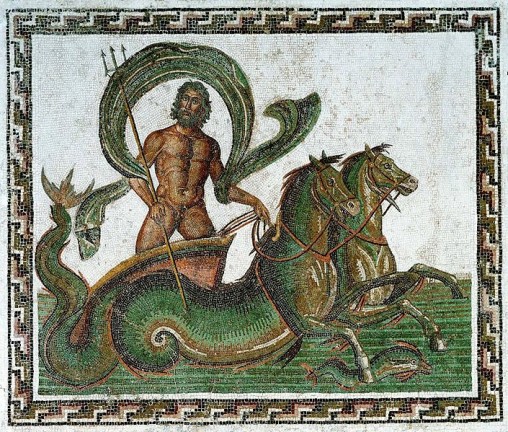This is a jump page to all the articles related to animal solar year markers.
To jest strona łącznikiem do wszystkich artykułów związanych ze znacznikami zwierzęcego roku słonecznego.
Indus Valley
Dolina Indusu
I came across this interesting Indus Valley civilisation bowl today.
Natknąłem się dzisiaj na tę interesującą misę cywilizacji Doliny Indusu.
Intrigued by the bull riding chicken, I spent an hour digging around to see if I can find more about this artefact. What I found is another amazing example of what can be read from ancient artefacts if you understand the lifecycles of the animals depicted on them and the climate of the area where the artefact was made…
Zaintrygowany kurakiem jadącym na byku, spędziłem godzinę, szukając informacji o tym artefakcie. To, co znalazłem, jest kolejnym niesamowitym przykładem tego, co można odczytać ze starożytnych artefaktów, jeśli zrozumiesz cykl życia przedstawionych na nich zwierząt i klimat obszaru, na którym powstał artefakt …
Indra, Hindu thunder god, arrives on Airavata, a white elephant, also called „Abhra-Matanga” (elephant of the clouds), „Naga-Malla” (the fighting elephant) and „Arkasodara” (brother of the sun)…
Indra, hinduski bóg piorunów, przybywa na Airavacie, białym słoniu, zwanym także „Abhra-Matanga” (słoń chmur), „Naga-Malla” (walczącym słońem) i „Arkasodara” (brat słońca)…
Why? Maybe because the mating season of the Asian elephant coincides with the monsoon season? More in:
Dlaczego? Może dlatego, że okres godowy słonia azjatyckiego zbiega się z porą monsunową? Więcej w:
Is it possible that the „decorations” on this ceramic vase made by the people of the Indus Valley civilisation symbolically depict the fishing season of the palla fish, the most important fish in Indus River?
Czy to możliwe, że „dekoracje” na tym wazonie ceramicznym wykonane przez mieszkańców cywilizacji doliny Indusu symbolicznie przedstawiają sezon połowu ryby palla, najważniejszej ryby w rzece Indus?
More in:
Arabia
Arabia
This amazing seal is one of many found in Dilmun, an ancient port located in today’s Bahrein which was founded in the late 4th millenium BC and abandoned in the mid 1st millennium BC…
Ta niesamowita pieczęć jest jedną z wielu znalezionych w Dilmun, starożytnym porcie położonym w dzisiejszym Bahrajnie, który został założony pod koniec 4 tysiąclecia pne i opuszczony w połowie 1 tysiąclecia pne …
This article gives the analysis of the symbols depicted on seal:
Ten artykuł zawiera analizę symboli przedstawionych na pieczęci:
Levant
Lewant
After the analysis of the animal symbolism from the Nahal Mishmar hoard found in Israel and dated 4000-3500BC, I proposed that the people who made these objects came from Iran, or Central Asia…It turned out genetic data from the site confirms this 100%
Po przeanalizowaniu symboliki zwierząt ze skarbu Nahal Mishmar znalezionego w Izraelu i datowanego na lata 4000-3500 pne zaproponowałem, aby ludzi, którzy wykonali te przedmioty, lokować w Iranie lub Azji Środkowej … Okazało się, że potwierdzają to w 100% dane genetyczne.
More in:
Arabian ostriches and snakes, depicted on a seal from Arslantepe, dated to the end of the 4th millennium BC…
Arabskie strusie i węże, przedstawione na pieczęci z Arslantepe, datowanej na koniec IV tysiąclecia pne …
Any reason behind the choice of animals depicted on this seal, or is this just random combination picked out of a hat? This article is trying to answer this question:
Czy jest jakiś powód wyboru zwierząt przedstawionych na tej pieczęci, czy jest to tylko przypadkowa kombinacja wybrana z kapelusza? Ten artykuł jest próbą odpowiedzi na to pytanie:
Terracotta lentoid flask, 11th century B.C. Levant. Both sides of the flask are decorated with goats, birds, and rudimentary foliage.
Terrakotowa falsza, XI wiek p.n.e. Lewant. Obie strony flaszy zdobią kozy, ptaki i szczątkowe liście.
Is the choice of the animals and the composition and grouping of animals random? I don’t think so. Here is why:
Czy wybór zwierząt oraz skład i pogrupowanie zwierząt są przypadkowe? Nie sądzę. Oto dlaczego:
This is „Lid of a pyxis originally containing face powder. Made in Ugarit, Syria, under Mycenaean influence, end of 2nd millennium BC”. Apparently depicting „Mistress of the animals feeding goats”…
To jest „Pokrywka puszki, która pierwotnie zawierała puder do twarzy. Wyprodukowano w Ugarit w Syrii, pod wpływem mykeńskim, koniec drugiego tysiąclecia pne”. Najwyraźniej przedstawia „Boginię Zwierząt karmiącą kozy” …
I would like to disagree with this interpretation of the scene. Here is why:
Nie zgadzam się z taką interpretacją sceny. Oto dlaczego:
I came across this peculiar early 9th century BC Urartian artefact recently.
Niedawno natknąłem się na ten osobliwy artefakt Urartu z początku IX wieku pne.
Which opens an interesting question: Were Anatolian Thunder Gods the first Drug Lords? More in:
Co otwiera interesujące pytanie: czy anatolijscy bogowie piorunów byli pierwszymi władcami narkotyków? Więcej w:
„As I looked, a stormy wind came out of the north: a great cloud with brightness around it and fire flashing forth continually, and in the middle of the fire, something like gleaming amber. In the middle of it was something like four living creatures. This was their appearance: they were of human form. Each had four faces, and each of them had four wings…As for the appearance of their faces: the four had the face of a human being, the face of a lion on the right side, the face of an ox on the left side, and the face of an eagle; such were their faces…” This is the vision that prophet Ezekiel had in the 6th century BC and prophet John had in the 1st century AD. This image gave birth to the Christian tetramorph, the union of the symbols of the Four Evangelists.
„Kiedy patrzyłem, z północy wiał burzowy wiatr: wielka chmura z jasnością wokół niej i nieustannie migoczącym ogniem, aw środku ognia coś jak lśniący bursztyn. W środku było coś jak cztery żyjące stworzenia. Taki był ich wygląd: miały ludzką postać. Każda miała cztery twarze, a każda z nich miała cztery skrzydła … Jeśli chodzi o wygląd ich twarzy: wszystkie cztery miały twarz człowieka, twarz lwa po prawej stronie, pysk wołu po lewej stronie i glowę orła; takie były ich twarze … „To jest wizja, którą miał prorok Ezechiel w VI wieku pne i prorok Jan w I wieku naszej ery. Ten obraz dał początek chrześcijańskiemu tetramorfowi, zjednoczeniu symboli czterech ewangelistów.
But what does this all mean? I believe that to understand the true meaning of this „vision” we need to look into the solar cult of Helios, the chariot and horses which Josiah removed from the Solomon’s Temple, the Celtic and Serbian cross quarter days calendar and the stone circles built by the Bronze Age Irish…
Ale co to wszystko oznacza? Uważam, że aby zrozumieć prawdziwe znaczenie tej „wizji”, musimy przyjrzeć się kultowi słonecznemu Heliosa, rydwanowi i koniom, które Jozjasz zabrał ze świątyni Salomona, kalendarzowi ćwierćdni krzyżowych celtyckich i serbskich oraz kamiennym kręgom zbudowanym w irlandzkiej epoce brązu.
https://oldeuropeanculture.blogspot.com/2019/04/four-living-creatures.html
Crete
Kreta
Norse thunder god Thor, Slavic thunder god Perun and Baltic thunder god Perkūnas all rode the sky in a chariot drawn by goats…Why?
Nordycki bóg piorunów Thor, słowiański bóg piorunów Perun i bałtycki bóg piorunów Perkūnas jechali po niebie rydwanem zaprzężonym w kozy … Dlaczego?
I think I have answered this question in this article. But the answer opens many many interesting questions about the possible origins of the North European mythology in Eastern Mediterranean…And it’s all to do with climate…
Myślę, że odpowiedziałem na to pytanie w tym artykule. Ale odpowiedź otwiera wiele interesujących pytań dotyczących możliwego pochodzenia mitologii północnoeuropejskiej we wschodniej części Morza Śródziemnego … A wszystko to ma związek z klimatem …
https://oldeuropeanculture.blogspot.com/2020/02/goat-riding-thunder-god.html
This is the so called „Sanctuary Rhyton” from Minoan palace of Zakros, dated to 1550-1500 BC, called so because its decoration depicts a Minoan mountain peak sanctuary…
To tak zwany „Rhyton Sanktuaryjny” z minojskiego pałacu Zakros, datowany na 1550-1500 pne, zwany tak, ponieważ obraz dekorujący go przedstawia minojskie sanktuarium na szczycie góry …
This article tries to fill a lot of holes in „our understanding” of this artefact…
Ten artykuł próbuje wypełnić wiele luk w „naszym zrozumieniu” tego artefaktu …
Cornucopia is latin name for the symbol of abundance and nourishment, which in classical antiquity was commonly depicted as a large horn-shaped container overflowing with produce, flowers or nuts…
Róg obfitości to łacińska nazwa symbolu dostatku i pożywienia, który w klasycznej starożytności był powszechnie przedstawiany jako duży pojemnik w kształcie rogu, pełen produktów, kwiatów lub orzechów
Ever wondered why a horn is a symbol of plenty? The answer to this question can be found in Minoan Crete. And its climate…More in:
Czy zastanawiałeś się kiedyś, dlaczego róg jest symbolem obfitości? Odpowiedź na to pytanie można znaleźć na Minojskiej Krecie. A jej klimat
Did Minoans paint chukar partridge eggs? In spring? As a fertility symbol? Partridges fresco from Knossos, ca. 1700-1500 B.C.
Czy minojczycy malowali jaja kuropatwy chukar?Wiosną? Jako symbol płodności? Fresk kuropatw z Knossos, ok. 1700-1500 pne
More in:
Egypt
Egipt
In the northern Sahara (Egypt) African wild cat breeding season runs from January to March. Gestation lasts for 56-68 days, meaning that kittens are usually born between March and May…Right on time for the grain harvest and the invasion of mice…Is this why the main festival of the Ancient Egyptian cat goddess Bastet was celebrated in April and May?
W północnej części Sahary (Egipt) sezon lęgowy dzikich kotów afrykańskich trwa od stycznia do marca. Ciąża trwa 56-68 dni, co oznacza, że kocięta rodzą się zwykle między marcem a majem … W samą porę na żniwa i inwazję myszy … obchodzony w kwietniu i maju?
Czy to dlatego główne święto starożytnej egipskiej bogini kotów Bastet obchodzono w kwietniu i maju?
More in:
This is Ra, in a shape of a Great Cat, killing Apep, the Great Snake, the creator of chaos and the enemy of order…Behind Apep is a growing tree (of life)…
To Ra, pod postacią Wielkiego Kota, zabijający Apepa, Wielkiego Węża, twórcę chaosu i wroga porządku … Za Apepem rośnie drzewo (życia) …
Meet Khnum. Khnum was one of the earliest-known Egyptian deities, originally the God of the source of the Nile. In art, Khnum was usually depicted as a ram-headed man holding a jar from which flowed a stream of water.
Poznaj Khnuma.Khnum był jednym z najwcześniej znanych egipskich bóstw, pierwotnie Bogiem źródła Nilu. W sztuce Khnum był zwykle przedstawiany jako mężczyzna z głową barana trzymający dzban, z którego wypływał strumień wody.
Ever wandered why he has a ram’s head? Is it possible that this has something to do with the actual lifecycle of wild goats?
Discussion in:
Czy zastanawiałeś się kiedyś, dlaczego ma głowę barana?Czy to możliwe, że ma to coś wspólnego z faktycznym cyklem życia dzikich kóz?Dyskusja w:
Ahhh. I always wandered why the Egyptian „Dog days” were located on the solar year at the hottest part of the year, the end of July, beginning of August…
Ahhh. Zawsze się zastanawiałem, dlaczego egipskie „psie dni” przypadały w roku słonecznym w najgorętszej części roku, koniec lipca, początek sierpnia …
So I looked at the Ancient Egyptian dog breeds…And what I have found is actually quite interesting…Another proof that our ancestors used the reoccurring events from the reproductive cycle of animals they were familiar with, to create solar year calendar markers…More in:
Więc przyjrzałem się rasom psów starożytnego Egiptu … I to, co znalazłem, jest w rzeczywistości dość interesujące … Kolejny dowód na to, że nasi przodkowie używali powtarzających się wydarzeń z cyklu reprodukcyjnego zwierząt, które znali, do tworzenia znaczników kalendarza słonecznego …Więcej w:
I apologise for not posting anything new in last few days. I have been wading through papyrus marshes of Egypt looking for the true identity of the Holy Cow…And I think I have found it.
Przepraszam, że w ciągu ostatnich kilku dni nie publikowałem niczego nowego. Wędrowałem przez papirusowe bagna Egiptu w poszukiwaniu prawdziwej tożsamości Świętej Krowy … I myślę, że ją znalazłem.
The result is in this article, which I hope you will enjoy reading:
Rezultat jest w tym artykule, który mam nadzieję, że ci się spodoba:
This is „aegis” plate from an Ancient Egyptian „menat”, a musical instrument/amulet which was sacred to the goddess Hathor.
To jest płyta „egida” ze starożytnego egipskiego „menata”, instrumentu muzycznego / amuletu, który był poświęcony bogini Hathor.
This is another interesting artefact that I came across recently which has a story to tell, if you know how to read it. Every symbol on this object is here for a reason and together they all point at the same moment in the Solar Year. More in:
This article is trying to answer the question: why is this white calf standing between two sycamore trees under a red sun?
Ten artykuł jest próbą odpowiedzi na pytanie: dlaczego ten biały cielec stoi między dwoma jaworami pod czerwonym słońcem?
For those interesting in how nature influences religions and religious symbolism…
Dla tych, którzy interesują się tym, jak natura wpływa na religie i symbolikę religijną …
Central Asia
Cenralna Azja
This amazing object is a silver gilt cast shaft-hole axe head, made between 2500-1500 BC in the area along the Oxus and Murghab rivers in modern Uzbekistan, Tajikistan, and Afghanistan.
Ten niesamowity obiekt to srebrna, pozłacana, odlewana głowica topora z otworem szybowym, wykonana w latach 2500-1500 pne na obszarze wzdłuż rzek Oxus i Murghab we współczesnym Uzbekistanie, Tadżykistanie i Afganistanie.
This is one of my favourite ancient objects. Why? Because it made me realise what double headed eagle means…
To jeden z moich ulubionych starożytnych przedmiotów. Dlaczego? Ponieważ uświadomiłem sobie, co oznacza dwugłowy orzeł …
Więcej w:
A one of a kind centaur: rhyton with a centaur holding a goat, currently in Ashmolean Museum of Art and Archaeology.
Jedyny w swoim rodzaju centaur: rhyton z centaurem trzymającym kozę, obecnie w Ashmolean Museum of Art and Archaeology.
Representing Sagittarius (The Hunter) catching Capricorn (The Goat) at the point of winter solstice???
Reprezentujący Strzelca (Łowcę/Łucznika) łapiącego Koziorożca (Koziorożca) w punkcie przesilenia zimowego ???
Among many seals found in ancient 2nd millennium BC Bactria, the ones depicting snakes and dragons are the most prevalent…
Spośród wielu stempli/pieczęci znalezionych w starożytnej Baktrii z drugiego tysiąclecia pne, te przedstawiające węże i smoki są najbardziej rozpowszechnione …
To the point where Nadezhda Dubova from the Institute of Ethnology and Anthropology of the Russian Academy of Science states that „…nowhere in the whole system of Ancient Near Eastern art had serpents played such an important role as in Bactria…” More in:
In 2011, this beautiful object was sold for 97,000 pounds sterling…A Bactrian gold stamp seal, c. 2200-1900 BC… Official description: „…central figure of a winged giant, with muscular human torso and legs, the head and talons of an eagle, wearing a short open tunic with wide belt, and a pendant necklace, grasping in each hand an inverted ibex…” What the heck is the meaning of this scene?
W 2011 roku ten piękny przedmiot został sprzedany za 97 000 funtów szterlingów … Baktryjski złoty stempel pieczęci, c. 2200-1900 pne… Oficjalny opis: „… centralna postać skrzydlatego olbrzyma, z umięśnionym ludzkim tułowiem i nogami, głową i szponami orła, ubrana w krótką otwartą tunikę z szerokim pasem i naszyjnikiem, chwyta w każdą dłoń odwrócone koziorożce… „Jakie jest znaczenie tej sceny?
One of the coolest lions ever. Bactrian seal. From: „Sulla Via delle Oasi. Tesori dell’Oriente Antico” Ligabue and Salvatori 1989, fig. 46, p. 196). Lion with „sun’s heat” rays coming out of his back. These are usually seen coming out of the shoulders of the Mesopotamia Sun God Utu (Shamash).
Jeden z najfajniejszych lwów wszechczasów. Pieczęć dwustronna. Od: „Sulla Via delle Oasi. Tesori dell’Oriente Antico” Ligabue i Salvatori 1989, ryc. 46, str. 196). Lew z promieniami „słońca” wychodzącymi z jego pleców. Są one zwykle przedstawiane jako wychodzące z ramion Mezopotamskiego boga słońca Utu (Szamasz).
More in:
Mesopotamia -Mezopotamia
Oriental Institute – University of Chicago posted this image on their facebook page the other day. OIM A32553; Late Uruk period, 3350-3100 BC; Iran, Chogha Mish…
Oriental Institute – University of Chicago niedawno opublikował to zdjęcie na swojej stronie na Facebooku. OIM A32553; Późny okres Uruk, 3350-3100 pne; Iran, Chogha Mish …
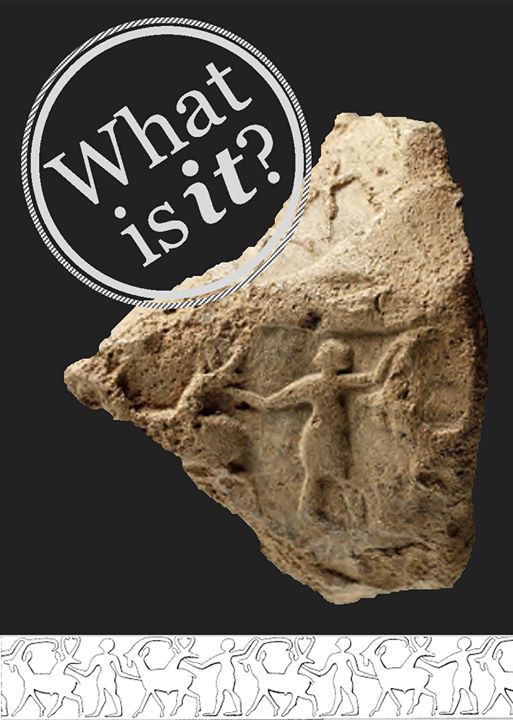
Their answer: „This artefact is a clay seal impression with a “master of animals” scene…First introduced during the Uruk period, this motif undoubtedly reflects increasing concern with managing the production of animals in the new urban economies.”
Ich odpowiedź brzmi: „Ten artefakt to odcisk glinianej pieczęci ze sceną„ pana zwierząt ”… Motyw ten, wprowadzony po raz pierwszy w okresie Uruk, niewątpliwie odzwierciedla rosnące zainteresowanie zarządzaniem produkcją zwierząt w nowych gospodarkach miejskich”.
My answer: „Master of animals is modern invention, created by archaeologists who couldn’t understand what all these images of people and animals meant”. There was never any „Master of the animals” in any of the cultures of the ancient world…
Moja odpowiedź: „Mistrz zwierząt to współczesny wynalazek, stworzony przez archeologów, którzy nie mogli zrozumieć, co oznaczają te wszystkie obrazy ludzi i zwierząt”. W żadnej z kultur starożytnego świata nigdy nie było żadnego „pana zwierząt” .
More in:
Another interesting seal. Akkadian, Tell Asmar. Description: „Sun god in a boat. On prow long-haired crowned figure with punting pole and human-headed lion, snake’s head for stern, plow, vase and two objects above, fertility goddess beside boat, fish below”
That’s it??? Well no obviously…There are a lot of interesting details on this seal that definitely deserve some explanation…More in:
Otóż to??? Cóż, nie, oczywiścieże nie … Na tej pieczęci jest wiele interesujących szczegółów, które zdecydowanie zasługują na wyjaśnienie … Więcej w:
This is a very interesting shell seal from the Early Dynastic IIIa period, ca. 2550– 2400 BC, inscribed: „Lugal-shà-pà-da”. Found in the dromos of the Queen Puabi’s Tomb. Kept in University of Pennsylvania Museum of Archaeology and Anthropology, Philadelphia.
The official description of the scene depicted on this Sumerian seal is kind of funny: „Nude Hero Grappling with Lions Attacking Horned Animals”…Ok, „lions attacking horned animals” part is kind of obvious. „Nude hero grappling with lions”…
Well that’s not at all obviously…More in:
Cóż, to wcale nie jest oczywiste … Więcej w:
The official description of the seal is: „Man prodding ox with which he is plowing; before ox, plant–In sky, crescent, star, seven globes…The scene…may have a ritual significance; perhaps…it depicts a rural ritual, in this case connected with agriculture”
Oficjalny opis pieczęci brzmi: „Człowiek szturchający wołu, którym orał; przed wołem, rośliną – Na niebie, półksiężycu, gwieździe, siedmiu globusach… Scena… może mieć znaczenie rytualne; być może… . przedstawia wiejski rytuał, w tym przypadku związany z rolnictwem ”
O my god! That’s it??? Let me see if I can decipher this image:
O mój Boże! Otóż to??? Zobaczmy, czy uda mi się rozszyfrować ten obraz:
This is one of the two identical Sumerian figures excavated in Ur, in southern Iraq, dated to c. 2600–2400 BC…This amazing work of art, depicts a horned animal with wings (???) standing on his hind legs and nibbling leaves from a flowering tree.
Jest to jedna z dwóch identycznych figur sumeryjskich wydobytych w Ur, w południowym Iraku, datowanych na ok. 2600–2400 pne … To niesamowite dzieło sztuki przedstawia rogatego zwierza ze skrzydłami (???) stojącego na tylnych łapach i skubiącego liście z kwitnącego drzewa.
What is the meaning of all this? And what can this tell us about (one) possible origin of the Sumerian civilisation? To figure this out, we need to look at climate and nature of Middle East and Central Asia…More in:
Co to wszystko ma znaczyć? A co to może nam powiedzieć o (jednym) możliwym pochodzeniu cywilizacji sumeryjskiej? Aby to rozgryźć, musimy przyjrzeć się klimatowi i naturze Bliskiego Wschodu i Azji Środkowej … Więcej w:
https://oldeuropeanculture.blogspot.com/2020/06/a-goat-in-tree.html
„Cylinder seal with monster” 😞 ca. 11th–9th century B.C. Elamite (Iran) . From Met museum.
Cylindryczna pieczęć z potworem – 😞 ok. XI – IX wiek pne Elamite (Iran). Z muzeum Met.
Another very interesting Akkadian cylinder seal from Tell Asmar, currently in the Oriental Institute of the University of Chicago.
Kolejna bardzo interesująca pieczęć akadyjska z Tell Asmar, obecnie w Oriental Institute na University of Chicago.
It depicts a very unusual ploughing scene…Which i would like to interpret because no one has done it so far…This seal basically a miniature farmer’s calendar which uses well known, recurring annual events from the lifecycle of animals depicted on the seal as solar year calendar markers…More in:
Przedstawia bardzo nietypową scenę orki … którą chciałbym zinterpretować, ponieważ nikt tego jeszcze nie zrobił … Ta pieczęć jest w zasadzie miniaturowym kalendarzem rolnika, który wykorzystuje dobrze znane, powtarzające się coroczne wydarzenia z cyklu życia zwierząt przedstawionych na pieczęci jako znaczniki kalendarza roku słonecznego … Więcej w:
Vase of Entemena, made during the reign of the Lagash king Entemena (c 2400 BC), is the finest example of metal engraving in Sumer.
Waza Entemena, wykonany za panowania króla Lagasz Entemeny (ok. 2400 pne), jest najlepszym przykładem grawerowania metalu w Sumerze.
This article is about these engravings, their meanings, and how can this vase point us to the true reason for Leo being where it is on Zodiac circle.
Ten artykuł dotyczy tych rycin, ich znaczenia i tego, jak ta waza może wskazać nam prawdziwy powód, dla którego Lew znajduje się tam, gdzie jest na okręgu zodiaku.
Is there a reason behind the choice of the animals found on Achaemenid rhytons? Zodiac? I think so.
Czy istnieje powód, dla którego wybrano zwierzęta znalezione na rytonach Achemenidów? Zodiak? Chyba tak.
More in:
This is truly incredible object. Composite Lion and Bull, bronze, Iran, 1500-1000 BC. It is currently kept in the Cleveland Art Museum. The meaning of this object is unknown. It is presumed that it has served as an object of worship in a temple or shrine…
To naprawdę niesamowity obiekt. Kompozyt lew i byk, brąz, Iran, 1500-1000 pne. Obecnie znajduje się w Muzeum Sztuki w Cleveland. Znaczenie tego obiektu jest nieznane. Przypuszcza się, że służył jako przedmiot kultu w świątyni lub ołtarzu.
Worship of who?
Uwielbienie kogo?
More in:
This is a seal from Tell Asmar, dated to 2200 BC. It depicts a seven headed dragon (beast with lion’s body and seven snake heads) with sun’s heat rays radiating out of its back, being speared by two gods (heroes)…
As Gary A. Rendsburg points out in his article „UT 68 and the Tell Asmar Seal” this is one of the most remarkable seals ever found and one of the most discussed… Why? Because the mythical theme of a hero (god) slaying multi headed dragon keeps popping up again and again in different cultures in Eurasia…
To jest pieczęć z Tell Asmar, datowana na 2200 pne. Przedstawia siedmiogłowego smoka (bestię z ciałem lwa i siedmioma głowami węża) z promieniami słońca promieniującymi z jego grzbietu, przeszywanego przez dwóch bogów (bohaterów) … Jak zauważył Gary A. Rendsburg w swoim artykule „UT 68 and the Tell Asmar Seal”, jest to jedna z najbardziej niezwykłych pieczęci, jakie kiedykolwiek znaleziono i jedna z najczęściej dyskutowanych… Dlaczego? Ponieważ mityczny motyw bohatera (boga) zabijającego wielogłowego smoka wciąż pojawia się w różnych kulturach w Eurazji …
More in:
Europe -Europa
This is one of the most amazing artefacts I have ever seen…Carved from a sperm whale tooth, it depicts two climbing Ibex goats…Found in Mas d’Azil cave (Ariège, France), Middle or Late Magdalenian (13000-10000BC), Piette collection, Musée D’Archéologie Nationale… What’s so exciting about this depiction of two goats? Well this could be the earliest clear example of the use of Ibex goats as solar calendar markers…
To jeden z najbardziej niesamowitych artefaktów, jakie kiedykolwiek widziałem … Wyrzeźbiony z zęba kaszalota przedstawia dwie wspinające się kozy (kozice-koziorożce) … Znaleziony w jaskini Mas d’Azil (Ariège, Francja), okres średnio lub późnomagdaleński (13000 -10000 pne), kolekcja Piette, Musée D’Archéologie Nationale … Co jest takiego ekscytującego w przedstawieniu dwóch kóz? Cóż, może to być najwcześniejszy wyraźny przykład wykorzystania kóz (kozic – koziorożców) jako znaczników kalendarza słonecznego …
More in:
Bowls from Los Millares
Have you seen these Orion depictions on Los Millares culture (Spain) bowls dated to around 3000BC?
Misy z Los Millares
Czy widziałeś te wizerunki Oriona na misach kultury Los Millares (Hiszpania) datowane na około 3000 lat pne?
And why were mating deer depicted next to it? More in:
A dlaczego z boku przedstawiono gody jelenia? Więcej w:
Zodiac
Zodiak
The position of all animal zodiac signs on the solar year, correspond to the time of the major annual lifecycle events of the animals in question in Europe. More in:


